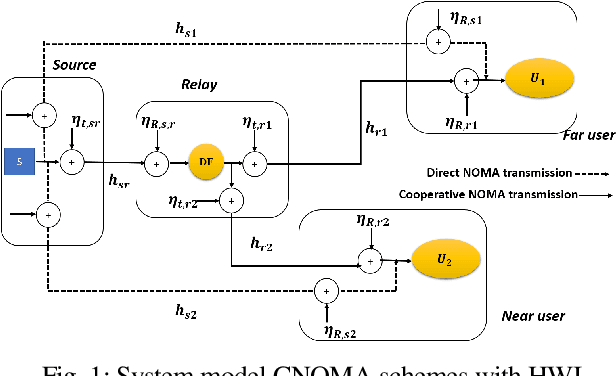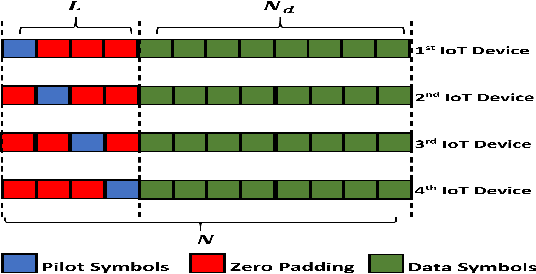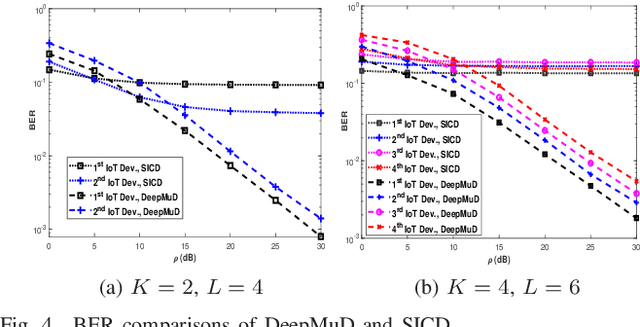Ferdi Kara
A Multi-layer Non-Terrestrial Networks Architecture for 6G and Beyond under Realistic Conditions and with Practical Limitations
Feb 22, 2025Abstract:In order to bolster the next generation of wireless networks, there has been a great deal of interest in non-terrestrial networks (NTN), including satellites, high altitude platform stations (HAPS), and uncrewed aerial vehicles (UAV). To unlock their full potential, these platforms can integrate advanced technologies such as reconfigurable intelligent surfaces~(RIS) and next-generation multiple access (NGMA). However, in practical applications, transceivers often suffer from radio frequency (RF) impairments, which limit system performance. In this regard, this paper explores the potential of multi-layer NTN architecture to mitigate path propagation loss and improve network performance under hardware impairment limitations. First, we present current research activities in the NTN framework, including RIS, multiple access technologies, and hardware impairments. Next, we introduce a multi-layer NTN architecture with hardware limitations. This architecture includes HAPS super-macro base stations (HAPS-SMBS), UAVs--equipped with passive or active transmissive RIS--, and NGMA techniques, like non-orthogonal multiple access (NOMA), as the multiple access techniques to serve terrestrial devices. Additionally, we present and discuss potential use cases of the proposed multi-layer architecture considering hardware impairments. The multi-layer NTN architecture combined with advanced technologies, such as RIS and NGMA, demonstrates promising results; however, the performance degradation is attributed to RF impairments. Finally, we identify future research directions, including RF impairment mitigation, UAV power management, and antenna designs.
Enabling 6G Performance in the Upper Mid-Band Through Gigantic MIMO
Jul 08, 2024Abstract:The initial 6G networks will likely operate in the upper mid-band (7-24 GHz), which has decent propagation conditions but underwhelming new spectrum availability. In this paper, we explore whether we can anyway reach the ambitious 6G performance goals by evolving the multiple-input multiple-output (MIMO) technology from being massive to gigantic. We describe how many antennas are needed and can realistically be deployed, and what the peak user rate and degrees-of-freedom (DOF) can become. We further suggest a new deployment strategy that enables the utilization of radiative near-field effects in these bands for precise beamfocusing, localization, and sensing from a single base station site. We also identify five open research challenges that must be overcome to efficiently use gigantic MIMO dimensions in 6G from hardware, cost, and algorithmic perspectives.
Error Performance Analysis of UAV-Mounted RIS for NOMA Systems with Practical Constraints
May 26, 2024Abstract:Uncrewed aerial vehicles (UAVs) have attracted recent attention for sixth-generation (6G) networks due to their low cost and flexible deployment. In order to maximize the ever-increasing data rates, spectral efficiency, and wider coverage, technologies such as reconfigurable intelligent surface (RIS) and non-orthogonal multiple access (NOMA) are adapted with UAVs (UAV-RIS NOMA). However, the error performance of UAV-RIS NOMA has not been considered, yet. In this letter, we investigate the error probability of UAV-RIS NOMA systems. We also consider the practical constraints of hardware impairments (HWI) at the transceivers, inter-cell interference (ICI), and imperfect successive interference cancellation (SIC). The analytical derivations are validated by Monte-Carlo simulations. Our results demonstrate that our proposed system achieves higher performance gain (more than 5 dB with increasing the number of RIS elements) with less error probability compared to UAVs without RIS. Moreover, it is found that the HWI, ICI, and imperfect SIC have shown a negative impact on the system performance.
Multi-Layer Network Formation through HAPS Base Station and Transmissive RIS-Equipped UAV
May 02, 2024Abstract:In order to bolster future wireless networks, there has been a great deal of interest in non-terrestrial networks, especially aerial platform stations including the high altitude platform station (HAPS) and uncrewed aerial vehicles (UAV). These platforms can integrate advanced technologies such as reconfigurable intelligent surfaces (RIS) and non-orthogonal multiple access (NOMA). In this regard, this paper proposes a multi-layer network architecture to improve the performance of conventional HAPS super-macro base station (HAPS-SMBS)-assisted UAV. The architecture includes a HAPS-SMBS, UAVs equipped with active transmissive RIS, and ground Internet of things devices. We also consider multiple-input single-output (MISO) technology, by employing multiple antennas at the HAPS-SMBS and a single antenna at the Internet of things devices. Additionally, we consider NOMA as the multiple access technology as well as the existence of hardware impairments as a practical limitation. In particular, we compare the proposed system model with three different scenarios: HAPS-SMBS-assisted UAV that are equipped with active transmissive RIS and supported by single-input single-output system, HAPS-SMBS-assisted UAV that are equipped with amplify-and-forward relaying, and HAPS-SMBS-assisted UAV-equipped with passive transmissive RIS. Sum rate and energy efficiency are used as performance metrics, and the findings demonstrate that, in comparison to all benchmarks, the proposed system yields higher performance gain. Moreover, the hardware impairment limits the system performance at high transmit power levels.
Bit-Interleaved Multiple Access: Improved Fairness, Reliability, and Latency for Massive IoT Networks
Apr 12, 2023Abstract:In this paper, we propose bit-interleaved multiple access (BIMA) to enable Internet-of-Things (IoT) networks where a massive connection is required with limited resource blocks. First, by providing a true power allocation (PA) constraint for conventional NOMA with practical constraints, we demonstrate that it cannot support massive connections. To this end, we propose BIMA where there are no strict PA constraints, unlike conventional NOMA, thus allowing a high number of devices. We provide a comprehensive analytical framework for BIMA for all key performance indicators (KPIs) (i.e., ergodic capacity [EC], outage probability [OP], and bit error rate [BER]). We evaluate Jain's fairness index and proportional fairness index in terms of all KPIs. Based on the extensive computer simulations, we reveal that BIMA outperforms conventional NOMA significantly, with a performance gain of up to 20-30dB. This performance gain becomes greater when more devices are supported. BIMA provides a full diversity order and enables the implementation of an arbitrary number of devices and modulation orders, which is crucial for IoT networks in dense areas. BIMA guarantees a fairness system where none of the devices gets a severe performance and the sum-rate is shared in a fair manner among devices by guarantying QoS satisfaction. Finally, we provide an intense complexity and latency analysis and demonstrate that BIMA provides lower latency compared to conventional NOMA since it allows parallel computing at the receivers and no iterative operations are required. We show that BIMA reduces latency by up to 350\% for specific devices and 170\% on average.
Error Analysis of Cooperative NOMA with Practical Constraints: Hardware-Impairment, Imperfect SIC and CSI
Jul 01, 2022

Abstract:Non-orthogonal multiple access (NOMA) has been a strong candidate to support massive connectivity in future wireless networks. In this regard, its implementation into cooperative relaying, named cooperative-NOMA (CNOMA), has received tremendous attention by researchers. However, most of the existing CNOMA studies have failed to address practical constraints since they assume ideal conditions. Particularly, error performance of CNOMA schemes with imperfections has not been investigated, yet. In this letter, we provide an analytical framework for error performance of CNOMA schemes under practical assumptions where we take into account imperfect successive interference canceler (SIC), imperfect channel estimation (ICSI), and hardware impairments (HWI) at the transceivers. We derive bit error rate (BER) expressions in CNOMA schemes whether the direct links between source and users exist or not which is, to the best of the authors' knowledge, the first study in the open literature. For comparisons, we also provide BER expression for downlink NOMA with practical constraints which has also not been given in literature, yet. The theoretical BER expressions are validated with computer simulations where the perfect-match is observed. Finally, we discuss the effects of the system parameters (e.g., power allocation, HWI level) on the performance of CNOMA schemes to reveal fruitful insights for the society.
A Hybrid Energy Harvesting Protocol for Cooperative NOMA: Error Performance Approach
Jul 01, 2022



Abstract:Cooperative non-orthogonal multiple access (CNOMA) has recently been adapted with energy harvesting (EH) to increase energy efficiency and extend the lifetime of energy-constrained wireless networks. This paper proposes a hybrid EH protocol-assisted CNOMA, which is a combination of the two main existing EH protocols (power splitting (PS) and time switching (TS)). The end-to-end bit error rate (BER) expressions of users in the proposed scheme are obtained over Nakagami-$m$ fading channels. The proposed hybrid EH (HEH) protocol is compared with the benchmark schemes (i.e., existing EH protocols and no EH). Based on the extensive simulations, we reveal that the analytical results match perfectly with simulations which proves the correctness of the derivations. Numerical results also show that the HEH-CNOMA outperforms the benchmarks significantly. In addition, we discuss the optimum value of EH factors to minimize the error probability in HEH-CNOMA and show that an optimum value can be obtained according to channel parameters.
Error Performance Analysis of Multi-user Detection in Uplink-NOMA with Adaptive $\mathcal{M}$-QAM
Apr 28, 2022



Abstract:This work provides a generalized performance analysis for the multi-user uplink-NOMA system with adaptive square quadrature amplitude modulation (QAM) over Rayleigh fading channels. Motivated by the massive IoT connections and unavailability of orthogonal resources for each node, we consider a multi-access scheme where multi-users with single-antenna transmit data to a multiple-antenna base station through the same resource block. By taking advantage of combining diversity paths with the proposed joint maximum-likelihood detector (JMLD), a closed form expression for the upper bound of bit error rate (BER) is obtained. Despite the number of users or the order of modulation, the analytical results endorsed via computer simulations reveal the ability of the MRC-JMLD detector to discard the error floor completely. Moreover, the simulation results show that the MRC-JMLD surpasses its counterparts significantly and ensures a full diversity order.
DeepMuD: Multi-user Detection for Uplink Grant-Free NOMA IoT Networks via Deep Learning
Feb 18, 2021



Abstract:In this letter, we propose a deep learning-aided multi-user detection (DeepMuD) in uplink non-orthogonal multiple access (NOMA) to empower the massive machine-type communication where an offline-trained Long Short-Term Memory (LSTM)-based network is used for multi-user detection. In the proposed DeepMuD, a perfect channel state information (CSI) is also not required since it is able to perform a joint channel estimation and multi-user detection with the pilot responses, where the pilot-to-frame ratio is very low. The proposed DeepMuD improves the error performance of the uplink NOMA significantly and outperforms the conventional detectors (even with perfect CSI). Moreover, this gain becomes superb with the increase in the number of Internet of Things (IoT) devices. Furthermore, the proposed DeepMuD has a flexible detection and regardless of the number of IoT devices, the multi-user detection can be performed. Thus, an arbitrary number of IoT devices can be served without a signaling overhead, which enables the grant-free communication.
Pilot Interval Reduction by Deep Learning Based Detectors in Uplink NOMA
Apr 26, 2020Abstract:Non-Orthogonal Multiple Access (NOMA) has higher spectral efficiency than orthogonal multiple access (OMA) techniques. In uplink communication systems that the channel is not known at the receiver, pilot signals sent from each user in different time intervals have reduced the spectral efficiency of NOMA. In this study, in the uplink communication system, DL-deep learning based detectors which are known to respond to the pilot signals sent from the users at the base station have been researched. It is aimed to maintain the spectral efficiency of NOMA by sending a single pilot from users, thus reducing the time interval in the DL detectors.
 Add to Chrome
Add to Chrome Add to Firefox
Add to Firefox Add to Edge
Add to Edge